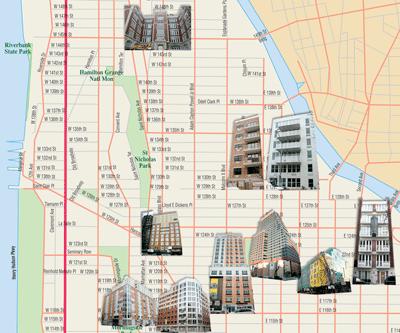
Click for a larger versionAfter steamrolling across the city, the condo boom headed to Harlem, promising high-end buildings in a neighborhood more known for historic brownstones. Many of those condos are now hitting the market during the bust, and developers are doing more than just dropping prices. They are looking for ways to trim costs, scale back amenities or squeeze margins.
The list of Harlem projects that have either just come on the market or are getting ready to launch is long.
In December, the 11-unit Sedona at 346 East 119th Street had a soft market launch, as did the 13-story Metropolis, which has 13 units, at 51 East 128th Street. The Douglass, at 2110 Frederick Douglass Boulevard, added 38 units to the market. At 2131 Frederick Douglass Boulevard, LivMor’s 73 condos were listed in January. The Madera, at 18 West 129th Street, has 12 units on the way. The Embelesar, at 152 East 118th Street, has 14. And the list goes on.
“They all jumped at the same time,” said Vie Wilson, senior vice president at the Corcoran Group, who is selling units at the Madera and the Embelesar. “It takes 18 months to two years to build out and that’s why right now there are a lot lined up to come on the market.”
That means the competition these days is intense.
“I was hoping to be closer to $600 [a square foot],” said Jacques Guillet, the project manager at the Metropolis. “I cut my expectations in terms of pricing.” Now, he’s asking in the mid-$500s a square foot.
But Guillet was also able to trim construction costs by slightly modifying the building’s green amenities. Rather than putting in a so-called live green roof, or landscaping over the entire roof, Guillet invested in “greening” 20 percent of the roof’s surface. The buyers, if they’re interested, can green the rest themselves.
Others are targeting margins.
“We didn’t cut back on the finishes or the amenities,” said Geoff Flournoy, one of the principals at BRP Development responsible for the Douglass, which is asking around $640 a foot. “It’s just tighter margins for everyone at this point.”
Some developers are choosing to stick to the prices they set from the start, even if it means holding out for buyers.
“To be completely candid, we forecasted that we could have more sold [by this point], but our price per square foot is the same,” said Hans Futterman, the president of RGS Holdings, which is developing 2280 FDB.
The 89-unit building has sold 31 units after 16 months on the market. The asking prices are in the mid-$700s a square foot. (Futterman also has plans for a mixed-use property directly across the street from 2280 FDB that will be “twice its size,” with a supermarket on the ground floor.)
And ironically, the timing may have helped Futterman. “Had we completed our building a year ago and were sitting on the market with a matured construction loan, we would have had to reduce prices to get rid of units because the financing structure has time lines,” he said. “Having not been completed was a big part of why we didn’t have to make substantial reductions.”
While Harlem developers are clearly struggling, none of the buildings are monoliths with 300 or 400 apartments to sell, like some new offers on the Upper East Side. Manhattan House on East 66th Street, for example, has 400-plus units.
And in some cases, Harlem developers have actually cut back on concessions as sales have improved.
The 32-unit Graceline Court, at 116th Street and Lenox Avenue, is a good example. The building is no longer offering 5 percent off the closing price because it has had six new deals signed since late fall.
After returning six deposits last summer, the developer lowered prices in the building twice. Units came on the market in 2007 at nearly $800 a square foot, but now are priced between $550 and $725, according to Leo Munoz, an agent at Halstead Property selling the project.
“A developer who went in expecting $600 to $700 a foot will have a different start today than one who went in expecting $900 a foot,” said Stephen Kliegerman, the executive director of new development marketing at Halstead, which is handling sales at a number of new condos in Harlem, including the Douglass at 2110 Frederick Douglass Boulevard and PS 90 Condominiums.
“The entire economic boom helped to buoy neighborhoods that had previously struggled,” said Kliegerman. “All this happened in 2005, on the tail end of the growth that was already being seen downtown.”
Lew Futterman, the developer of Fifth on the Park, said at the “height of the market we were 97 percent sold,” but that “some of those fell by the wayside” after buyers backed out. The 159-unit building, which went on the market in May 2007, has closed between 40 and 50 percent.
Still, Harlem developers have an edge: Prices, even at $700 a square foot, are still lower than they are on the Upper East Side, the Upper West Side and in Lower Manhattan. Units at the Sedona, for example, start at $430,000, or $580 a square foot.
“You have to remember that Harlem has the lowest price per square foot in the city,” Corcoran’s Wilson said. “So when the market fell we were the first place to lose ground, but when it recovers we’ll be the first place to gain it because it’s still the cheapest price per square foot in Manhattan.”
